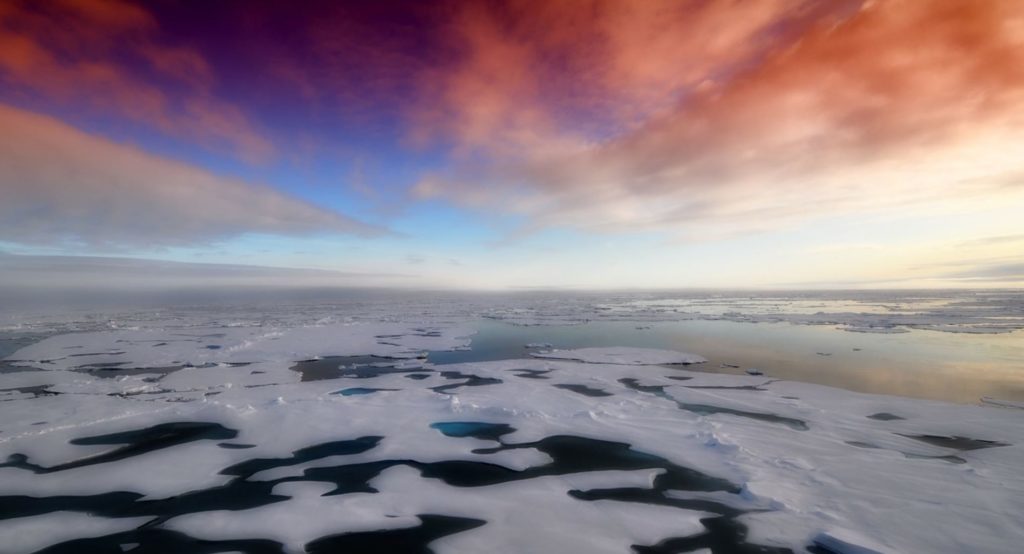A newly published study about the climate of the mid-Cretaceous period claims to have discovered evidence of a 90-million-year-old temperate rainforest that once existed in the South Pole region of Antarctica, proving the old maps of Piri Reis and Oronteus Finaeus.
The Piri Reis and Oronteus Finaeus maps have always contradicted the claim that Antarctica’s deep freeze happened 34 million years ago showing rainforests. Both maps being from the 15th century detail the continent’s vegetation not showing a shred of ice.
An international team of geoscience researchers recently discovered the evidence while aboard the research icebreaker RV Polarstern in the Amundsen Sea near the Pine Island Glacier. Using a drill they descended to ocean depths of 3,300 feet and then penetrated through to 90 feet beneath the seafloor to extract a perfectly preserved sample of forest soil with a sediment core composed of fine-grained silt and clay.
In their paper, recently published in Nature, the scientists wrote:
A sedimentary sequence recovered from the West Antarctic shelf—the southernmost Cretaceous record reported so far—and show that a temperate lowland rainforest environment existed at a palaeolatitude of about 82° S during the Turonian–Santonian age (92 to 83 million years ago).
A CT scan of the soil revealed densely packed fossil roots, pollen, and spores of at least 65 types of vegetation including conifers, ferns, and flowering plants. No animal fossils were recovered but the soil was dated to about 90 million years ago, which is the Jurassic Period of the dinosaurs. With average annual temperatures of about 53-55 degrees Fahrenheit (12-13 Celsius)—68-77 Fahrenheit (20-25 Celsius) during the warmest summer months—scientists say this region, 560 miles from the South Pole, would have been a swampy rainforest full of dinosaurs, flying pterosaurs, and insects.
“The preservation of this 90-million-year-old forest is exceptional, but even more surprising is the world it reveals,” said the study’s co-author Professor Tina van de Flierdt, from the Department of Earth Science & Engineering at Imperial. “Even during months of darkness, swampy temperate rainforests were able to grow close to the South Pole, revealing an even warmer climate than we expected.”
Recent discoveries in the past few years suggest that we don’t know all there is to know about the snowy continent as we arrogantly assume. After all the continent is 5.405 million miles large with ice intact. Buried under all that ice so far we have discovered — unknown life forms, and even potentially the world’s largest canyon.
That’s not all, in Vostok — the largest subglacial lake in Antarctica — researchers have even discovered unknown bacteria that lives off air alone. In 2017, researchers conducted another study, this time not digging under the ocean or lakes of Antarctica but rather taking samples of fossilized tree remains. The scientists found 13 fossil fragments from trees dating back more than 260 million years, around the time of the world’s greatest mass extinction event according to National Geographic. It’s not just trees and bacteria, in 2008 scientists collected nearly 30,000 different life forms many of which were unknown.
Further, soil samples retrieved from the caves surrounding Antarctica on Ross Island have revealed intriguing traces of DNA from mosses, algae and small animals. Elsewhere on the continent, in what’s known as the Wilkes Land, a huge and mysterious “anomaly” is thought to be lurking beneath the frozen wasteland. This anomaly is theorized to be the remains of a truly massive asteroid more than twice the size of the Chicxulub space rock that wiped out the dinosaurs and caused the Permian-Triassic extinction event, which killed 96 percent of Earth’s sea creatures and up to 70 percent of organisms living on land.
There will be even more hidden history disclosed about the continent of Antarctica within the coming months to years when the sheets of ice melt, revealing what is hidden beneath. Antarctica was once a rainforest according to scientists, like the moon, and oceans on the large once icy continent that continues to melt hold much of our hidden origins.
Although, ridiculed as “conspiracy,” Antarctica indeed likely has artifacts and archaeology; this shouldn’t be too shocking to believe since every continent we have explored has had history from our past from monoliths to pyramids. And this is the last place on earth that has not been formally fully explored due to the conditions.
**By [@An0nkn0wledge](https://steemit.com/@an0nkn0wledge)**
Aaron Kesel writes for Activist Post.
Subscribe to Activist Post for truth, peace, and freedom news. Become an Activist Post Patron for as little as $1 per month at Patreon. Follow us on SoMee, Flote, Minds, Twitter, and Steemit.
Provide, Protect and Profit from what’s coming! Get a free issue of Counter Markets today.
